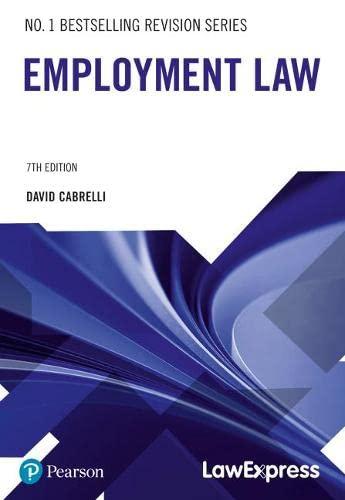Question
Business law 2342 The fourth adjustment is the payment of a lease agreement for equipment used by the companies. Glenwood simply rents the equipment for
Business law 2342
The fourth adjustment is the payment of a lease agreement for equipment used by the companies. Glenwood simply rents the equipment for one year at a time, payable on December 31 of each year. The adjustment for this lease is a debit to rent expense and a credit to cash. Eads capitalizes the lease as an asset because they agree to lease the equipment for eight years, paying $16,000 at the end of each year to cover both the rent expense and the interest expense. The last adjustment deals with income tax provisions. The stated rate for income tax is 25 percent; thus, each company sets aside 25 percent of their income before taxes to pay to the IRS for income tax. Glenwood has a higher income, so their income tax expense is more than Eads'. These adjustments affect net income, an important aspect to examine before lending to or investing in a company. Net income, however, is not the only important aspect to consider. Other aspects to consider include cash flows, which show that the company is a going concern throughout the fiscal year; current assets, which show liquidity; and property, plant, and equipment, which show possible collateral against a loan. These are shown on the statement of cash flows and the balance sheet, respectively, which are included below for both Glenwood and Eads. These statements of cash flow below provide insight on the company as an operation as well as in its peripheral transactions. Glenwood has overall greater cash flow, but Eads' net cash from operating activities is a greater amount. Part of this is due to Eads' capitalization of the lease agreement, compared to Glenwood's payment at the end of the year. This one adjustment method can impact the decisions of many investors and lenders. 7 Eads Company Statement of Cash Flows For year ended December 31, 20X1 Cash Flows from Operating Activities Net income $70,515 Adjustments Depreciation on PP&E 41,500 Interest on Note payable 6,650 Changes in current assets Accounts receivable (94,430) Inventory (51,000) Changes in current liabilities Accounts payable 26,440 Net cash from operating activities $(325) Cash flows from investing activities Purchases of PP&E (500,000) Lease of equipment (92,000) Net cash from investing activities $(592,000) Cash flows from financing activities Proceeds from long term debt 400,000 Payment on long term debt (20,000) Net cash from financing activities $380,000 Net increase (decrease) in cash (212,325) Cash balance January 1, 20X1 - Cash balance December 31, 20X1 $(212,325) Glenwood Company Statement of Cash Flows For year ended December 31, 20X1 Cash Flows from Operating Activities Net income $92,742 Adjustments Depreciation on PP&E 19,000 Interest on note payable 6,650 Changes in current assets Accounts receivable (98,406) Inventory (62,800) Changes in current liabilities Accounts payable 26,440 Net cash from operating activities $(16,374) Cash flows from investing activities Purchases of PP&E (500,000) Net cash from investing activities $(500,000) Cash flows from financing activities Proceeds from long term debt 400,000 Payment on long term debt (20,000) Net cash from financing activities $380,000 Net increase (decrease) in cash (136,374) Cash balance January 1, 20X1 - Cash balance December 31, 20X1 $(136,374) 8 Glenwood Company Classified Balance Sheet As of December 31, 20X1 Assets Liabilities Current Assets Current Liabilities Cash $426.00 Accounts payable $26,440.00 Accounts Receivable $99,400.00 Interest payable $6,650.00 Allowance for Bad Debts $(994.00) Current portion of note payable $20,000.00 Inventory $62,800.00 Total Current Liabilities $53,090.00 Total Current Assets $161,632.00 Long term liabilities Property, Plant, & Equipment Note payable $360,000.00 Land $70,000.00 Total Liabilities $413,090.00 Building $350,000.00 Accumulated depreciation - building $(10,000.00) Stockholders' Equity Equipment $80,000.00 Common Stock $160,000.00 Accumulated depreciation - equipment $(9,000.00) Retained Earnings $69,542.00 Total Property, Plant, & Equipment $481,000.00 Total Stockholders' Equity $229,542.00 Total Assets $642,632.00 Total Liabilities & Stockholders' Equity $642,632.00 9 Eads Company C
Question 1 Please what is (are) the likely cause(s) of sudden sharp but brief pain (resembling pin prick) in the right lower abdomen? Question 2 What are the causes of foot drop, and what is the likely treatment? Question 3 What is the correct definition for dysaesthesia? Question 4 What is the difference between 'light touch' and 'fine touch' sensations passed in the posterior column, and which one of these is tested with a wisp of cotton? Question 5 What is apraxia of gait and what is Brun's apraxia? Question 6 Why is it that, when eliciting the plantar reflex, we are supposed to stop just before the ball of the great toe? Question 7 Is there any rationale for giving dopamine agonists to aphasic patients? Question 8 Have either carbamazepine or dopamine agonists a role in the treatment of aphasia? If yes, what type of aphasia? 221 21 Neurological disease 222 Question 9 Is bilateral VIth cranial nerve palsy always a false-localizing sign (i.e. does it indicate an increased intracranial pressure and not pathology of the nerves or their nuclei)? Question 10 Can an optic tract lesion, which is mononuclear field loss (i.e. loss of vision in one eye) also be called 'incongruous homonymous hemianopia'? Question 11 How would you treat optic neuritis?
Step by Step Solution
There are 3 Steps involved in it
Step: 1

Get Instant Access to Expert-Tailored Solutions
See step-by-step solutions with expert insights and AI powered tools for academic success
Step: 2

Step: 3

Ace Your Homework with AI
Get the answers you need in no time with our AI-driven, step-by-step assistance
Get Started


